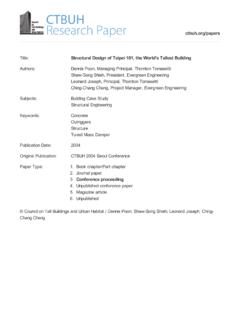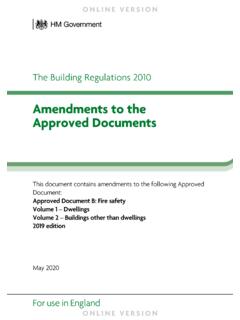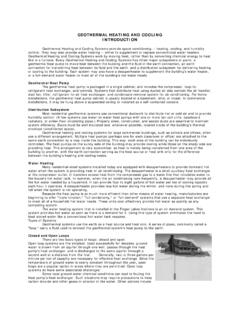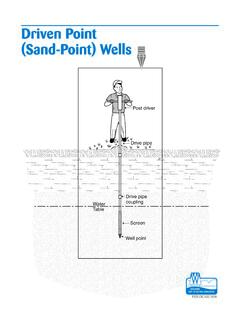Transcription of Continental Margins - Geology
1 1 Continental Margins Introduction he Continental margin is the submerged shelf and slope forming the outer edge of a major landmass. The differences between oceanic and Continental crust composition are fundamental in margin development. The transition between the two crustal types lies under the area of the Continental slope with the shelf over Continental crust and oceanic crust below the Continental rise. The difference in densities and isostatic balance of the Continental to oceanic crustal blocks is expressed dramatically by the presence of a Continental slope, which is the great declivity from the shelf break downward to deep ocean depths. It is a continuous and impressive geomorphic feature -- an escarpment of more than three kilometers height and 15 to 50 km width that extends for more than 350,000 kilometers.
2 The Continental shelf is the submerged part of the continent lying between the coastline and the shelf break, which is the change in inclination marking the boundary between Continental shelf and slope. The average gradient of the shelf is only seven minutes of inclination, and off coastal plain shorelines, the shelf is a submerged continuation of the plain that has alternated between submergence and emergence during geologic time. Plate tectonics provides the framework for interpreting the history and character of the Continental Margins . Plate movements and the basic difference in the density of oceanic and Continental crustal units initiate the structural pattern of Continental Margins and result in a tectonic classification of coastlines as active (Pacific, leading edge) or passive (Atlantic, trailing edge) Margins , each of which have certain fundamental characteristics.
3 Active Continental Margins , where plates are converging, coincide with plate boundaries, where the Continental and oceanic crust are separated by a subduction zone. These Margins are active tectonically and have less width and sediment input than passive Margins . They are also marked by the addition of blocks from distant sources to the Continental mass at the subduction zone. Passive Margins are within plates and are separated from the oceanic ridge plate margin by an expanse of oceanic crust that was generated after rifting. Oceanic and Continental crust meet in a region of low tectonic activity that does however experience a broad pattern of subsidence. Passive Margins are generally wide and may receive a large influx of terrigenous sediments or intrabasin carbonate sedimentation from local sources.
4 This presentation is divided into three parts examination of Continental margin structure, sediment patterns on the Margins and the morphology or surface features. Composition of the margin rocks carbonate or terrigenious produces different features. But the history of most Margins shows periods of both carbonate and terrigenous development. margin Structure late tectonics provides us with basic types of Continental margin . The difference between passive and active Margins is basic to describing the structure and morphology. T P 2 Passive Margins passive margin (Atlantic margin ) lies within a plate at the boundary between Continental and oceanic crust. The major tectonic movement is broad, regional vertical adjustment and both earthquake and volcanic activity are minor and local.
5 These Margins are marked by smooth relief due to tectonic inactivity and major sediment accumulation. Thermal cooling and sediment loading have led to a general condition of subsidence and sediment accumulation as the margin moves away from the spreading center. Modern passive Margins bound the oceans formed by the spreading involved in the break-up of the Paleozoic supercontinent which includes: the North and South Atlantic oceans, the Indian Ocean, the Arctic and Norwegian seas, and the Margins of Antarctica. The initial rifting was preceded by regional uplift and vulcanism over a rising convection current cell or plume with the rifting area either above or below sea level after an initial period of crustal thinning and erosion. If rifting occurred within a Continental block, magma penetrates the rift, and begins the accretion of oceanic crust at the edges of the separated blocks.
6 The shape of a passive margin is inherited from the trend and character of the initial rift, but it also reflects subsequent modification. The present form of many Continental slopes results from prograding sedimentation over the initial tectonic slope . The configuration and internal characteristics of the sedimentary sequences are controlled by tectonically driven subsidence (isostasy), and by the character and influx of available terrigenous sediment supply. The Margins may also be modified by in situ carbonate sediment production. The North American continent is growing along the Atlantic slope and the shelf break advances seaward as sediments accumulate over older strata. The sequence in the growth of the Atlantic margin is a model for divergent margin development.
7 Following the rifting and initial accretion of oceanic crust, the Atlantic grew to over 1,000 kilometers wide during the Jurassic, but this early ocean was shallow because it was over the spreading center. The rifted Margins subsided, forming basins in which Continental and marine sediments accumulated with evaporites forming in restricted basins. Sills, dikes and lava flows were injected into predominantly non-marine sediments during the early (Triassic) history. The rate of subsidence slowed with time as the margin cooled, but the accumulating sediment contributed to the sink rate. A 3 During the late Cretaceous and Cenozoic, the controls on shelf sedimentation were regional warping and faulting and eustatic sea level changes. Subsidence with sediment influx and accumulation of sediments continued on the shelf and a Continental rise was developed by turbidity current deposits from the shelf and slope.
8 North America margin structure 4 The east coast of the North American continent between Nova Scotia and Florida is typical of a divergent margin , with Triassic clastics and shales deposited in a lacustrine environment followed by late Triassic salt deposits in a restricted basin. Early Jurassic carbonates and evaporites and middle Jurassic shelf carbonates were deposited in an elevated rift valley and they were followed by deltaic sands and a change to clastic sedimentation as the margin subsided. Major differences in the sediment pattern and sediment types occur from north to south along this coast that reflect not only source differences, but also differences in the transport and deposition processes. A Grand Bank The overlying Tertiary is a thin sediment layer of about 300 meters on the Continental shelf.
9 It thickens beneath the Continental rise to about five kilometers of prograding slope forming a constructional, subsiding margin . The sediments are underlain by Continental crustal rock under the shelf and by oceanic rock beyond the base of the Continental rise. The Grand Bank section shows a truncation of the prograded beds of the slope and erosional effects . B Nova Scotia The Nova Scotia-Georges Bank section has less well-developed fault blocks and no salt or evaporite deposition. The seismic section is characteristic of a faulted margin with deposition on a sinking crust with a margin dam of oceanic basement . C New Jersey Off New Jersey, the ancient Continental slope (Cretaceous to Eocene) thickens at the slope-to-rise transition in response to a decreased seaward slope.
10 This shelf had a reef margin dam. A landward shift of the shelf break occurred after early Eocene, and the Eocene surface is exposed along the lower slope. Large deltas of Miocene and Pliocene age migrated over the shelf and across part of the slope to form a different type of Continental shelf locally. Delta Margins are a significant type of subsiding and prograding margin and deltaic sequences have been seen in Tertiary strata of the Continental margin in many studies. Modern deltas such as the Mississippi Delta have produced a modification of the basic subsidence model by extending across the shelf and slope, and depressing the shelf several kilometers. D Florida The same basic rift pattern is present in the Florida section, but Jurassic carbonates lie directly over the rift zone and a reef margin dam persisted from Jurassic through Cretaceous.







